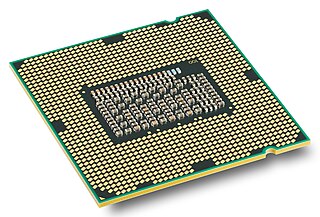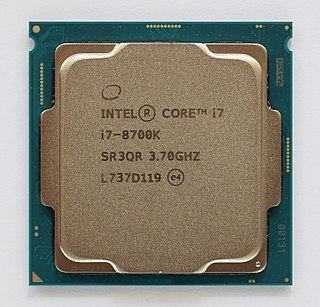Related Research Articles

In computing, BIOS (, BY-oss, -ohss; Basic Input/Output System is firmware used to provide runtime services for operating systems and programs and to perform hardware initialization during the booting process. The BIOS firmware comes pre-installed on an IBM PC or IBM PC compatible's system board and exists in UEFI-based systems too. The name originates from the Basic Input/Output System used in the CP/M operating system in 1975. The BIOS originally proprietary to the IBM PC has been reverse engineered by some companies looking to create compatible systems. The interface of that original system serves as a de facto standard.
An undocumented feature is an unintended or undocumented hardware operation, for example an undocumented instruction, or software feature found in computer hardware and software that is considered beneficial or useful. Sometimes the documentation is omitted through oversight, but undocumented features are sometimes not intended for use by end users, but left available for use by the vendor for software support and development. Also, some unintended operation of hardware or software that ends up being of utility to users is simply a bug, flaw or quirk.
System Management Mode is an operating mode of x86 central processor units (CPUs) in which all normal execution, including the operating system, is suspended. An alternate software system which usually resides in the computer's firmware, or a hardware-assisted debugger, is then executed with high privileges.
A hardware bug is a defect in the design, manufacture, or operation of computer hardware that causes incorrect operation. It is the counterpart of software bugs which refer to flaws in the code which operates computers, and is the original context in which "bug" was used to refer to such flaws. Intermediate between hardware and software are microcode and firmware which may also have such defects. In common usage, a bug is subtly different from a "glitch" which may be more transient than fundamental, and somewhat different from a "quirk" which may be considered useful or intrinsic. Errata may be published by the manufacturer to reflect such unintended operation, and "errata" is sometimes used as a term for the flaws themselves.

Sandy Bridge is the codename for Intel's 32 nm microarchitecture used in the second generation of the Intel Core processors. The Sandy Bridge microarchitecture is the successor to Nehalem and Westmere microarchitecture. Intel demonstrated a Sandy Bridge processor in 2009, and released first products based on the architecture in January 2011 under the Core brand.

Intel Active Management Technology (AMT) is hardware and firmware for remote out-of-band management of select business computers, running on the Intel Management Engine, a microprocessor subsystem not exposed to the user, in order to monitor, maintain, update, upgrade and repair them. Out-of-band (OOB) or hardware-based management is different from software-based management and software management agents.

Intel Core is a line of streamlined midrange consumer, workstation and enthusiast computer central processing units (CPUs) marketed by Intel Corporation. These processors displaced the existing mid- to high-end Pentium processors at the time of their introduction, moving the Pentium to the entry level. Identical or more capable versions of Core processors are also sold as Xeon processors for the server and workstation markets.

The Intel Management Engine (ME), also known as the Intel Manageability Engine, is an autonomous subsystem that has been incorporated in virtually all of Intel's processor chipsets since 2008. It is located in the Platform Controller Hub of modern Intel motherboards.
Project Zero is a team of security analysts employed by Google tasked with finding zero-day vulnerabilities. It was announced on 15 July 2014.
Intel Software Guard Extensions (SGX) is a set of security-related instruction codes that are built into some Intel central processing units (CPUs). They allow user-level and operating system code to define protected private regions of memory, called enclaves. SGX is designed to be useful for implementing secure remote computation, secure web browsing, and digital rights management (DRM). Other applications include concealment of proprietary algorithms and of encryption keys.

Coffee Lake is Intel's codename for its eighth generation Core microprocessor family, announced on September 25, 2017. It is manufactured using Intel's second 14 nm process node refinement. Desktop Coffee Lake processors introduced i5 and i7 CPUs featuring six cores and Core i3 CPUs with four cores and no hyperthreading.

Kernel page-table isolation is a Linux kernel feature that mitigates the Meltdown security vulnerability and improves kernel hardening against attempts to bypass kernel address space layout randomization (KASLR). It works by better isolating user space and kernel space memory. KPTI was merged into Linux kernel version 4.15, and backported to Linux kernels 4.14.11, 4.9.75, and 4.4.110. Windows and macOS released similar updates. KPTI does not address the related Spectre vulnerability.

Meltdown is a hardware vulnerability affecting Intel x86 microprocessors, IBM POWER processors, and some ARM-based microprocessors. It allows a rogue process to read all memory, even when it is not authorized to do so.

Spectre is a subset of security vulnerabilities within the class of vulnerabilities known as microarchitectural timing side-channel attacks. These affect modern microprocessors that perform branch prediction and other forms of speculation. On most processors, the speculative execution resulting from a branch misprediction may leave observable side effects that may reveal private data to attackers. For example, if the pattern of memory accesses performed by such speculative execution depends on private data, the resulting state of the data cache constitutes a side channel through which an attacker may be able to extract information about the private data using a timing attack.
Speculative Store Bypass (SSB) is the name given to a hardware security vulnerability and its exploitation that takes advantage of speculative execution in a similar way to the Meltdown and Spectre security vulnerabilities. It affects the ARM, AMD and Intel families of processors. It was discovered by researchers at Microsoft Security Response Center and Google Project Zero (GPZ). After being leaked on 3 May 2018 as part of a group of eight additional Spectre-class flaws provisionally named Spectre-NG, it was first disclosed to the public as "Variant 4" on 21 May 2018, alongside a related speculative execution vulnerability designated "Variant 3a".
Lazy FPU state leak, also referred to as Lazy FP State Restore or LazyFP, is a security vulnerability affecting Intel Core CPUs. The vulnerability is caused by a combination of flaws in the speculative execution technology present within the affected CPUs and how certain operating systems handle context switching on the floating point unit (FPU). By exploiting this vulnerability, a local process can leak the content of the FPU registers that belong to another process. This vulnerability is related to the Spectre and Meltdown vulnerabilities that were publicly disclosed in January 2018.

Foreshadow, known as L1 Terminal Fault (L1TF) by Intel, is a vulnerability that affects modern microprocessors that was first discovered by two independent teams of researchers in January 2018, but was first disclosed to the public on 14 August 2018. The vulnerability is a speculative execution attack on Intel processors that may result in the disclosure of sensitive information stored in personal computers and third-party clouds. There are two versions: the first version (original/Foreshadow) targets data from SGX enclaves; and the second version (next-generation/Foreshadow-NG) targets virtual machines (VMs), hypervisors (VMM), operating systems (OS) kernel memory, and System Management Mode (SMM) memory. A listing of affected Intel hardware has been posted.

The Microarchitectural Data Sampling (MDS) vulnerabilities are a set of weaknesses in Intel x86 microprocessors that use hyper-threading, and leak data across protection boundaries that are architecturally supposed to be secure. The attacks exploiting the vulnerabilities have been labeled Fallout, RIDL, ZombieLoad., and ZombieLoad 2.
Transient execution CPU vulnerabilities are vulnerabilities in a computer system in which a speculative execution optimization implemented in a microprocessor is exploited to leak secret data to an unauthorized party. The classic example is Spectre that gave its name to this kind of side-channel attack, but since January 2018 many different vulnerabilities have been identified.
References
- ↑ Bruce Schneier (January 5, 2018). "Spectre and Meltdown Attacks Against Microprocessors – Schneier on Security". www.schneier.com. Retrieved February 4, 2019.
Spectre and Meltdown are pretty catastrophic vulnerabilities, ...
- ↑ "This Week in Security: Internet Meltdown Over Spectre of CPU Bug". Cylance.com. 2018-01-05. Retrieved February 4, 2019.
The security implications of the Meltdown and Spectre vulnerabilities are indeed catastrophic for systems engineering.
- ↑ "Meltdown, Spectre: here's what you should know". Rudebaguette.com. January 8, 2018. Retrieved February 4, 2019.
[sic]: The effects of these vulnerabilities are catastrophic: « at best, the vulnerability can be used by malwares and hackers to exploit other security linked bugs. At worse, the flaw can be used by software and authentified users to read the kernel’s memory
- ↑ Lucian Armasu (29 March 2019). "Intel Chipsets' Undocumented Feature Can Help Hackers Steal Data". Tom's Hardware.